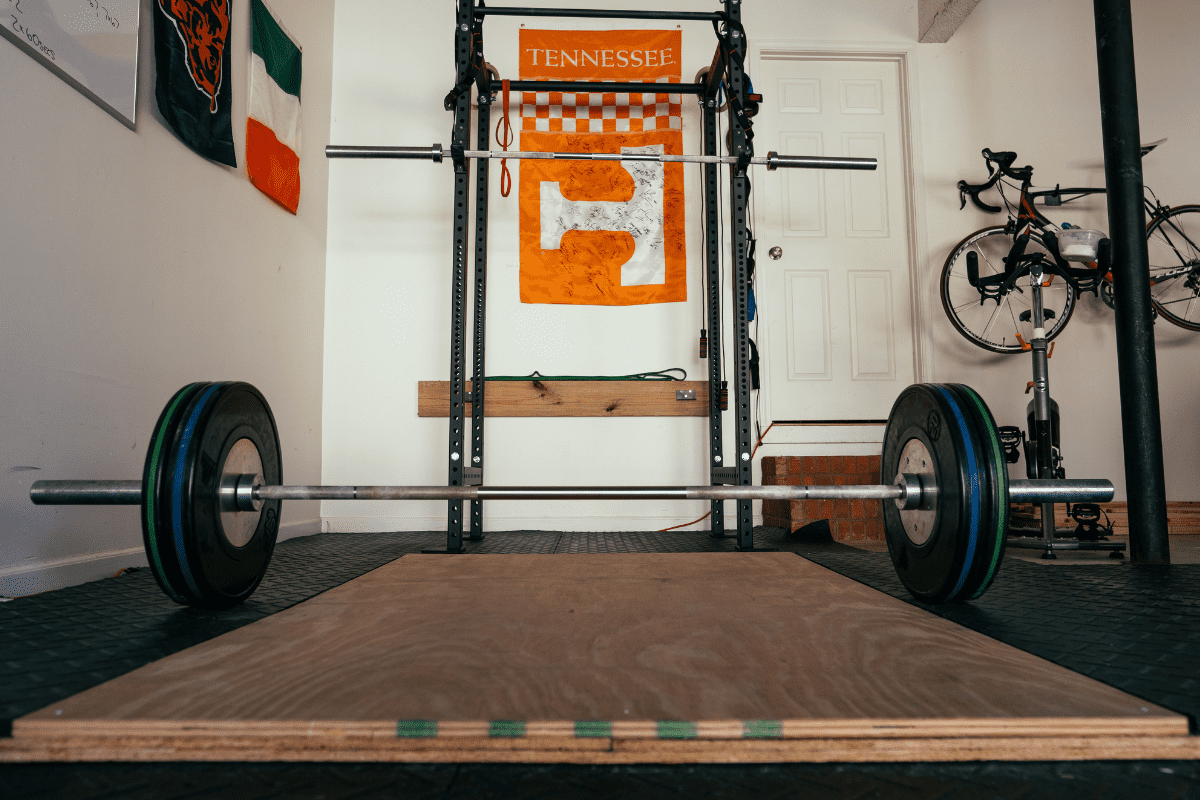The 9 Garage Gym Essentials You Need to Start Your Gym
So, you’ve decided to build out your garage into the garage gym of your dreams, or at least a workout space that allows you to not have to drive to that big box gym every day.
Either way, Congratulations!
Now, comes the important first step in building out your own garage gym – What are the Garage Gym Essentials that should be at the top of your buying list? Buying gym equipment can get pretty expensive pretty fast, so most of us start with the basic essentials and then add pieces over time from there.
The key is to get the most bang for your buck in those first purchases. This consists of buying pieces that are going to provide you with the ability to do all the fundamental lifts as well as give you lots of versatility to mix up your workouts.
In this article, I’m going to give you a guide to the 9 garage gym essentials that I recommend you get first and why.
Garage Gym Essentials – Tier 1
These Tier 1 Essentials are pieces of home gym equipment that regardless of your lifting style, every garage gym owner will want in their own garage gym asap.
Barbell
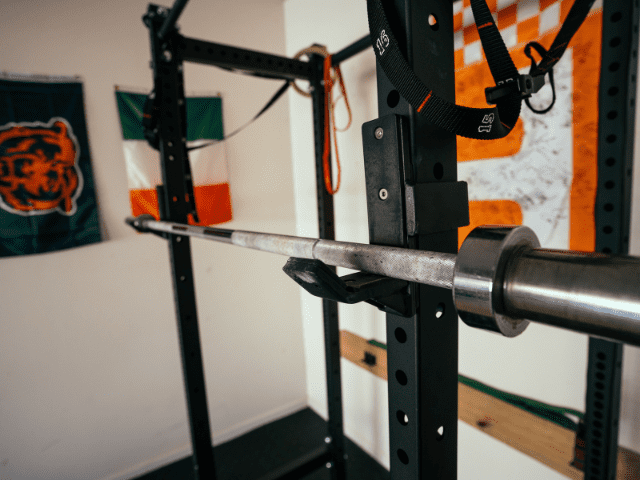
The Barbell is the quintessential piece of any gym, whether it’s in a garage gym or a college weight room. With nothing more than a Barbell and some bumper plates (which we’re going to address shortly), you can perform an almost limitless amount of exercises and complete workouts.
Olympic lifts, squats, bench press, deadlifts, rows – pretty much all of your fundamental strength and muscle-building lifts are performed with a barbell.
Considering the amount of value and versatility you’re getting with a barbell, they’re also extremely cost-effective as well. You can pick up a quality barbell that will last you years and years for around $200.
Sure, you can do at-home workouts with just dumbbells or a TRX Strap and there’s absolutely nothing wrong with that. But if you want a full-on garage gym – then finding a quality barbell should be at the top of your priority list.
Plates
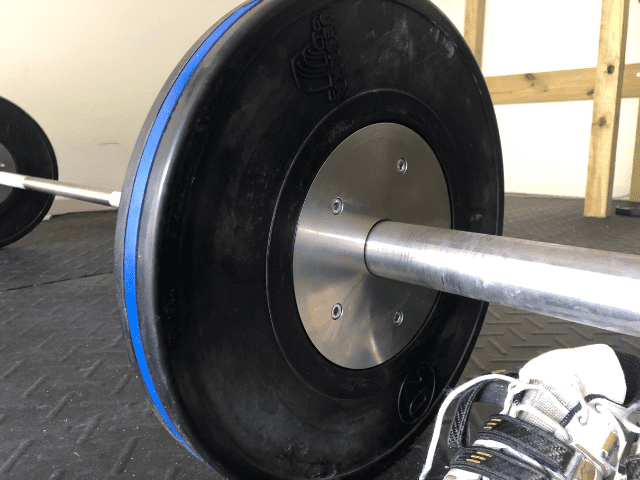
The second most essential piece of garage gym equipment is weight plates.
They’re really the ‘1B’ to the barbell’s ‘1A’. Weight plates are what is going to give your barbell all of that versatility to challenge you across a variety of lifts.
The real questions when it comes to plates are, ‘How much weight do I need’ and ‘Do I need Bumper Plates or Iron Plates‘?
In my opinion, how much weight you need depends on how strong you are. That may seem obvious, but let me elaborate.
For me personally, how much weight I need depends on my squat. On a really good day, I can still get close to around a 495 squat. So I make sure I have that much weight available to me. If your heaviest lift is 315, then there is really no need for you to have more weight than that.
Whether or not you’ll want bumper plates depends on your lifting style. If you’re going to be doing Olympic lifts (this includes Crossfit) then you’re going to want bumper plates. Iron plates rotate extremely poorly and don’t exactly do well with being dropped on the ground repeatedly.
If you’re powerlifting and deadlifting is a big priority, then it really comes down to your personal preference. I like deadlifting with bumpers, but I know guys who like iron plates better. Bumper plates are probably better for your garage floor long-term, but that decision is ultimately up to you.
If you’re not planning on doing any of the lifts I just described and you’re just going to be doing basic lifts and bodybuilding-style workouts, then iron plates will do the job great. They’re cheaper, look great and will do everything you’re going to ask of them.
Squat Rack
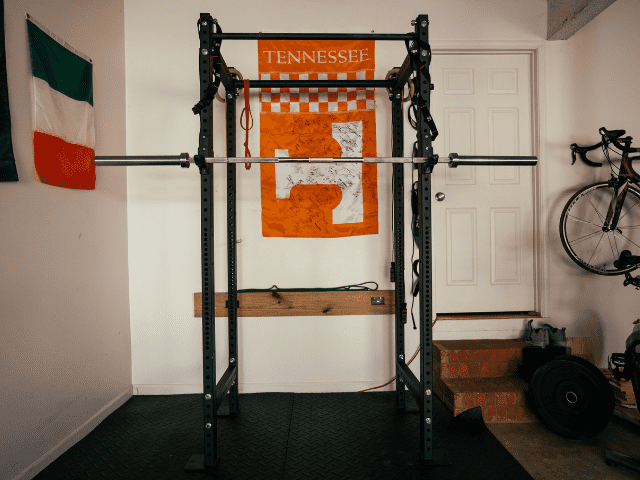
Third on the list of must-have essentials when you begin building out your garage gym is a Rack.
What kind of a rack will depend upon your budget and needs. You can get anything from a Full Power Rack to a simple set of Squat Stands. The cost of a rack can vary from a couple of hundred dollars for a Squat Stand to well over a thousand for top-of-the-line Power Racks.
Generally speaking, I would recommend Squat Stands for more advanced lifters who have a small space to work with, or for pure Olympic lifters who only need a rack for a few exercises.
A full size rack will generally be safer for a more novice lifter (a full rack is more stable and usually will include safety catches for squats) and will give you a ton more variety.
Regardless of which rack you choose, a rack allows you to Back Squat and the ability to Back Squat is non-negotiable if you want to call your garage an actual gym.
Seriously, though, a rack opens up an insane amount of extra lifts for your workouts.
Even more so if you have a rack with a pull-up bar built-in. A pull-up bar for pull-ups is another essential that you can buy separately although one already built into your rack is a great cost and space saver.
With a barbell, bumper plates and a rack you can perform an almost limitless amount of lifts and workouts. In fact, I’ve trained college football teams for two decades and I’d estimate that around 75% of everything we do is done with just these three pieces of equipment.
My last Tier 1 essential for a home gym is not something you’re going to lift with, rather it’s what you’re going to lift on.
Flooring
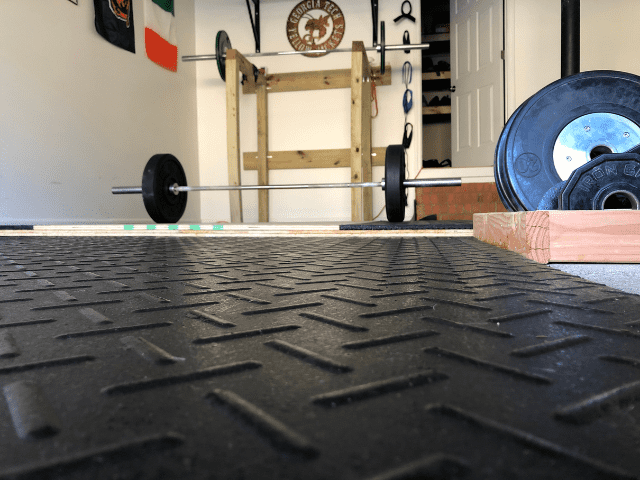
If you’re serious about building a garage gym and this is the space that you’re going to be using on a daily basis to drop weights, do core work and everything else that comes with working out – you need to invest in some flooring.
Lifting on a bare garage floor is not a good idea for the long-term health of both your floor and your weights.
Flooring is one of the best investments you can make for your garage gym and it doesn’t even have to be all that expensive.
I use (and recommend) horse stall mats from a store like Tractor Supply Company. They’re thick, durable and at about $50 each for a 4-foot by 6-foot piece – they are a low-cost investment for how much long-term value they’ll bring.
I have a good friend who has been running a successful gym for over a decade now. What does he have in his gym? The same set of horse stall mats that he bought when he opened the place and they’re still in great shape.
Bonus Tip: How To Get The Smell Out of Horse Stall Mats
You don’t need to cover your entire floor either. Where are you going to be primarily lifting? Where will you be dropping weights – both barbells and dumbbells? Cover these areas with flooring.
Those are my four Tier 1 essentials which you can put together even with a budget as low as $1000.
Tier 2 Gym Equipment
Tier 2 essentials are going to be somewhat dependent on lifting style. Depending on how you lift, these Tier 2 items could be either very essential or might not be needed at all.
Weight Bench
A weight bench is the perfect example of a Tier 2 essential. For some, the idea of not having a bench for their garage gym is complete insanity. After all, how are you supposed to bench press without a bench?
Well, this may come as a shock to some, but some people aren’t that into benching. I am one of those people. I prefer cleans over bench press and years of football made benching a nightmare for my shoulders. I’m 3 years into my garage gym journey and I still don’t have a bench.
However, if you celebrate national bench press day every Monday, then a Bench is going to be an essential piece of equipment right behind your bar, plates and rack.
And, relatively speaking, a bench isn’t that crazy expensive. You can get a good flat bench for less than $200. If you want to be able to do incline presses and rows, you’ll need an adjustable bench – just know that a good adjustable bench will cost you about double what a flat bench will.
If you’re not into benching, I’m guessing this next Tier 2 essential may be more your style.
Read More:
Platform
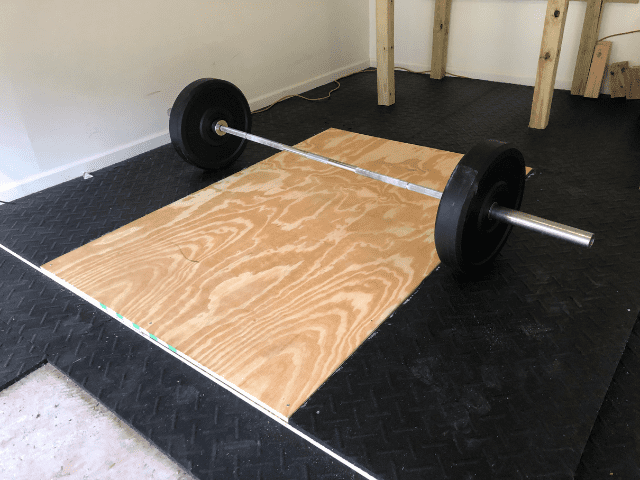
If you’re going to be doing a lot of Olympic lifting (again, this definitely includes Crossfit) then I’d highly suggest getting yourself a platform.
A platform is going to give another layer of protection to your garage floor, in addition to the gym flooring you’ve already laid down. This is really beneficial if you’re going to be doing things like clean and jerks or heavy deadlifts.
I’ve also found that having a platform helps tremendously with deadening the sound that comes with dropping heavy weights. My wife doesn’t necessarily hear every set being dropped now like before I started using my platform.
From a cost standpoint, you may want to look into building your own platform. Buying one and having it delivered can set you back a good bit of money. However, I built my own and not only did it cost me less than $150, it was a pretty easy build.
Having said all this, if you’re not planning on doing some of the lifts that I’m describing then there’s probably very little need for you to worry about having a platform for your gym.
Dumbbells

Dumbbells are another great Tier 2 essential. While you don’t absolutely need dumbbells, almost all of us are going to want dumbbells for our gym sooner or later.
One could even make the argument that you could forego the barbell and plates and instead opt for a few sets of dumbbells. And while that’s not the setup I would want personally, you could definitely go that route if you wanted to.
Buying a whole set of dumbbells can get quite expensive, so I suggest being a bit strategic with what weights you want and/or need.
I have a set of dumbbells that range from 5 pounds up to 50 pounds along with a set of adjustable dumbbells.
This is partly due to the fact that these weights cover most of my dumbbells needs (single arm snatches, presses and the occasional set of curls mostly). The other reason is these are the weights I’ve found at estate sales which is my favorite way of buying used equipment.
Plyo Box
My final Tier 2 essential is one that is geared heavily towards the Crossfit community.
There are certain pieces of equipment that will come up in workouts quite often. For most pieces, you can find a suitable sub from the pieces of equipment I’ve already covered. Subbing Thrusters in place of a Wall Ball for instance is a great swap until you get yourself a med ball.
In my opinion, a Box Jumps is one of the hardest movements to sub for. Yes, you could do squat jumps or something similar, but high volume jumping and landing without a box can be really hard on the joints (especially for us older ‘athletes’).
You can get a Plyo Box for a little over $100, depending upon which type of plyo box you decide to get. This makes it an inexpensive purchase that you’ll get a ton of use out of.
Jump Rope
For my 9th and final garage gym essential, I’m suggesting the humble jump rope.
Sure, I could’ve gone with something much sexier like a Glute Ham Developer, Kettlebells or even a piece of cardio equipment like a Rower or Treadmill, but nope, I’m going jump rope here.
The jump rope is one of, if not the most undervalued and underappreciated piece of gym equipment.
For starters, you can get a jump rope for less than $20. (Here are some other home gym accessories you can get for under $20)
Next, it’s versatility is amazing. Need something to prime the CNS and get the heart rate up before a workout? Jump Rope.
Need a cardio finisher at the end of a workout? Try five minutes of jump rope.
Trying to help improve footwork and coordination with an athlete? Jump Rope.
I use my jump rope almost as much as my barbell in my garage gym and I wouldn’t want to replace it with any bigger, ‘fancier’ piece of equipment.

Get Shredded… For Free
Get a free workout Monday through Friday, posted right here on Horton Barbell. These workouts are designed to help you get strong, in shape and look great at the beach!
Final Thoughts
This wraps up my 9 Garage Gym Essentials – 4 Tier 1 and 5 more Tier 2 essentials.
These 9 pieces of equipment are a great starting point for anyone looking to turn their garage into an iron mecca. Or just someone picking up a hobby that can last them a lifetime.
Once you have your essentials in place, you can begin to start branching out into more specialized pieces depending on your personal preferences.
Bottom line, get the items that you feel are essential to help you achieve your goals and get training!
Stay Strong!

